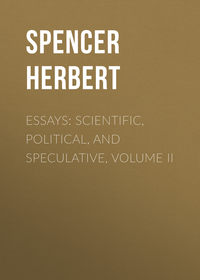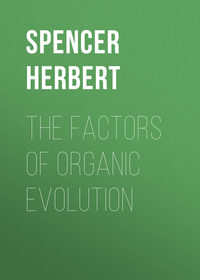 полная версия
полная версияThe Principles of Biology, Volume 1 (of 2)
In the last chapter (§ 2) we incidentally noted the extreme instability of nitrogenous compounds in general. We saw that sundry of them are liable to explode on the slightest incentive – sometimes without any apparent cause; and that of the rest, the great majority are very easily decomposed by heat, and by various substances. We shall perceive much significance in this general characteristic when we join it with the fact that the substances capable of setting up extensive molecular changes in the way above described are all nitrogenous ones. Yeast consists of vegetal cells containing nitrogen, – cells that grow by assimilating the nitrogenous matter contained in wort. Similarly, the "vinegar-plant," which greatly facilitates the formation of acetic acid from alcohol, is a fungoid growth that is doubtless, like others of its class, rich in nitrogenous compounds. Diastase, by which the transformation of starch into sugar is effected during the process of malting, is also a nitrogenous body. So too is a substance called synaptase – an albumenous principle contained in almonds, which has the power of working several metamorphoses in the matters associated with it. These nitrogenized compounds, like the rest of their family, are remarkable for the rapidity with which they decompose; and the extensive changes produced by them in the accompanying carbo-hydrates, are found to vary in their kinds according as the decompositions of the ferments vary in their stages. We have next to note, as having here a meaning for us, the chemical contrasts between those organisms which carry on their functions by the help of external forces, and those which carry on their functions by forces evolved from within. If we compare animals and plants, we see that whereas plants, characterized as a class by containing but little nitrogen, are dependent on the solar rays for their vital activities; animals, the vital activities of which are not thus dependent, mainly consist of nitrogenous substances. There is one marked exception to this broad distinction, however; and this exception is specially instructive. Among plants there is a considerable group – the Fungi – many members of which, if not all, can live and grow in the dark; and it is their peculiarity that they are very much more nitrogenous than other plants. Yet a third class of facts of like significance is disclosed when we compare different portions of the same organism. The seed of a plant contains nitrogenous substance in a far higher ratio than the rest of the plant; and the seed differs from the rest of the plant in its ability to initiate, in the absence of light, extensive vital changes – the changes constituting germination. Similarly in the bodies of animals, those parts which carry on active functions are nitrogenous; while parts that are non-nitrogenous – as the deposits of fat – carry on no active functions. And we even find that the appearance of non-nitrogenous matter throughout tissues normally composed almost wholly of nitrogenous matter, is accompanied by loss of activity: what is called fatty degeneration being the concomitant of failing vitality. One more fact, which serves to make still clearer the meaning of the foregoing ones, remains – the fact, namely, that in no part of any organism where vital changes are going on, is nitrogenous matter wholly absent. It is common to speak of plants – or at least all parts of plants but the seeds – as non-nitrogenous. But they are only relatively so; not absolutely. The quantity of albumenoid substance in the tissues of plants, is extremely small compared with the quantity contained in the tissues of animals; but all plant-tissues which are discharging active functions have some albumenoid substance. In every living vegetal cell there is a certain part that includes nitrogen as a component. This part initiates those changes which constitute the development of the cell. And if it cannot be said that it is the worker of all subsequent changes undergone by the cell, it nevertheless continues to be the part in which the independent activity is most marked.
Looking at the evidence thus brought together, do we not get an insight into the actions of nitrogenous matter as a worker of organic changes? We see that nitrogenous compounds in general are extremely prone to decompose: their decomposition often involving a sudden and great evolution of energy. We see that the substances classed as ferments, which, during their own molecular changes, set up molecular changes in the accompanying carbo-hydrates, are all nitrogenous. We see that among classes of organisms, and among the parts of each organism, there is a relation between the amount of nitrogenous matter present and the amount of independent activity. And we see that even in organisms and parts of organisms where the activity is least, such changes as do take place are initiated by a substance containing nitrogen. Does it not seem probable, then, that these extremely unstable compounds have everywhere the effect of communicating to the less unstable compounds associated with them, molecular movements towards a stable state, like those they are themselves undergoing? The changes which we thus suppose nitrogenous matter to produce in the body, are clearly analogous to those which we see it produce out of the body. Out of the body, certain carbo-hydrates in continued contact with nitrogenous matter, are transformed into carbonic acid and alcohol, and unless prevented the alcohol is transformed into acetic acid: the substances formed being thus more highly oxidized and more stable than the substances destroyed. In the body, these same carbo-hydrates, in continued contact with nitrogenous matter, are transformed into carbonic acid and water: substances which are also more highly oxidized and more stable than those from which they result. And since acetic acid is itself resolved by further oxidation into carbonic acid and water; we see that the chief difference between the two cases is, that the process is more completely effected in the body than it is out of the body. Thus, to carry further the simile used above, the molecules of carbo-hydrates contained in the tissues are, like bricks on end, not in the stablest equilibrium; but still in an equilibrium so stable, that they cannot be overthrown by the chemical and thermal forces which the body brings to bear on them. On the other hand, being like similarly-placed bricks that have very narrow ends, the nitrogenous molecules contained in the tissues are in so unstable an equilibrium that they cannot withstand these forces. And when these delicately-poised nitrogenous molecules fall into stable arrangements, they give impulses to the more firmly-poised non-nitrogenous molecules, which cause them also to fall into stable arrangements. It is a curious and significant fact that in the arts, we not only utilize this same principle of initiating extensive changes among comparatively stable compounds, by the help of compounds much less stable, but we employ for the purpose compounds of the same general class. Our modern method of firing a gun is to place in close proximity with the gunpowder which we wish to decompose or explode, a small portion of fulminating powder, which is decomposed or exploded with extreme facility, and which, on decomposing, communicates the consequent molecular disturbance to the less-easily decomposed gunpowder. When we ask what this fulminating powder is composed of, we find that it is a nitrogenous salt.10
Thus, besides the molecular re-arrangements produced in organic matter by direct chemical action, there are others of kindred importance produced by indirect chemical action. Indeed, the inference that some of the leading transformations occurring in the animal organism, are due to this so-called catalysis, appears necessitated by the general aspect of the facts, apart from any such detailed interpretations as the foregoing. We know that various amylaceous and saccharine matters taken as food do not appear in the excreta, and must therefore be decomposed in their course through the body. We know that these matters do not become components of the tissues, but only of the contained liquids and solids; and that thus their metamorphosis is not a direct result of tissue-change. We know that their stability is such that the thermal and chemical forces to which they are exposed in the body, cannot alone decompose them. The only explanation open to us, therefore, is that the transformation of these carbo-hydrates into carbonic acid and water, is due to communicated chemical action.
§ 16. This chapter will have served its purpose if it has given a conception of the extreme modifiability of organic matter by surrounding agencies. Even were it possible, it would be needless to describe in detail the immensely varied and complicated changes which the forces from moment to moment acting on them, work in living bodies. Dealing with biology in its general principles, it concerns us only to notice how specially sensitive are the substances of which organisms are built up to the varied influences that act upon organisms. Their special sensitiveness has been made sufficiently manifest in the several foregoing sections.
CHAPTER III.
THE RE-ACTIONS OF ORGANIC MATTER ON FORCES
§ 17. Re-distributions of Matter imply concomitant re-distributions of Motion. That which under one of its aspects we contemplate as an alteration of arrangement among the parts of a body, is, under a correlative aspect, an alteration of arrangement among certain momenta, whereby these parts are impelled to their new positions. At the same time that a force, acting differently on the different units of an aggregate, changes their relations to one another; these units, reacting differently on the different parts of the force, work equivalent changes in the relations of these to one another. Inseparably connected as they are, these two orders of phenomena are liable to be confounded together. It is very needful, however, to distinguish between them. In the last chapter we took a rapid survey of the re-distributions which forces produce in organic matter; and here we must take a like survey of the simultaneous re-distributions undergone by the forces.
At the outset we are met by a difficulty. The parts of an inorganic mass undergoing re-arrangement by an incident force, are in most cases passive – do not complicate those necessary re-actions that result from their inertia, by other forces which they themselves originate. But in organic matter the re-arranged parts do not re-act in virtue of their inertia only. They are so constituted that an incident force usually sets up in them other actions which are much more important. Indeed, what we may call the indirect reactions thus caused, are so great in their amounts compared with the direct re-actions, that they quite obscure them.
The impossibility of separating these two kinds of reaction compels us to disregard the distinction between them. Under the above general title, we must include both the immediate re-actions and those re-actions mediately produced, which are among the most conspicuous of vital phenomena.
§ 18. From organic matter, as from all other matter, incident forces call forth that re-action which we know as heat. More or less of molecular vibration necessarily results when, to the forces at work among the molecules of any aggregate, other forces are added. Experiment abundantly demonstrates this in the case of inorganic masses; and it must equally hold in the case of organic masses. In both cases the force which, more markedly than any other, produces this thermal re-action, is that which ends in the union of different substances. Though inanimate bodies admit of being greatly heated by pressure and by the electric current, yet the evolutions of heat, thus induced are neither so common, nor in most cases so conspicuous, as those resulting from chemical combination. And though in animate bodies there are certain amounts of heat generated by other actions, yet these are secondary to the heat generated by the action of oxygen on the substances composing the tissues and the substances contained in them. Here, however, we see one of the characteristic distinctions between inanimate and animate bodies. Among the first there are but few which ordinarily exist in a condition to evolve the heat caused by chemical combination; and such as are in this condition soon cease to be so when chemical combination and genesis of heat once begin in them. Whereas, among the second there universally exists the ability, more or less decided, thus to evolve heat; and the evolution of heat, in some cases very slight and in no cases very great, continues as long as they remain animate bodies.
The relation between active change of matter and re-active genesis of molecular vibration, is clearly shown by the contrasts between different organisms, and between different states and parts of the same organism. In plants the genesis of heat is extremely small, in correspondence with their extremely small production of carbonic acid: those portions only, as flowers and germinating seeds, in which considerable oxidation is going on, having decidedly raised temperatures. Among animals we see that the hot-blooded are those which expend much force and respire actively. Though insects are scarcely at all warmer than the surrounding air when they are still, they rise several degrees above it when they exert themselves; and in mammals, which habitually maintain a temperature much higher than that of their medium, exertion is accompanied by an additional production of heat.
This molecular agitation accompanies the falls from unstable to stable molecular combinations; whether they be those from the most complex to the less complex compounds, or whether they be those ultimate falls which end in fully oxidized and relatively simple compounds; and whether they be those of the nitrogenous matters composing the tissues or those of the non-nitrogenous matters diffused through them. In the one case as in the other, the heat must be regarded as a concomitant. Whether the distinction, originally made by Liebig, between nitrogenous substances as tissue-food and non-nitrogenous substances as heat-food, be true or not in a narrower sense, it cannot be accepted in the sense that tissue-food is not also heat-food. Indeed he does not himself assert it in this sense. The ability of carnivorous animals to live and generate heat while consuming matter that is almost exclusively nitrogenous, suffices to prove that the nitrogenous compounds forming the tissues are heat-producers, as well as the non-nitrogenous compounds circulating among and through the tissues: a conclusion which is indeed justified by the fact that nitrogenous substances out of the body yield heat, though not a large amount, during combustion. But most likely this antithesis is not true even in the more restricted sense. The probability is that the hydrocarbons and carbo-hydrates which, in traversing the system, are transformed by communicated chemical action, evolve, during their transformation, not heat alone but also other kinds of force. It may be that as the nitrogenous matter, while falling into more stable molecular arrangements, generates both that molecular agitation called heat and such other molecular movements as are resolved into forces expended by the organism; so, too, does the non-nitrogenous matter. Or perhaps the concomitants of this metamorphosis of non-nitrogenous matter vary with the conditions. Heat alone may result when it is transformed while in the circulating fluids, but partly heat and partly another force when it is transformed in some active tissue that has absorbed it; just as coal, though producing little else but heat as ordinarily burnt, has its heat partially transformed into mechanical motion if burnt in a steam-engine furnace. In such case the antithesis of Liebig would be reduced to this – that whereas nitrogenous substance is tissue-food both as material for building-up tissue and as material for its function; non-nitrogenous substance is tissue-food only as material for function.
There can be no doubt that this thermal re-action which chemical action from moment to moment produces in the body, is from moment to moment an aid to further chemical action. We before saw (First Principles, § 100) that a state of raised molecular vibration is favourable to those re-distributions of matter and motion which constitute Evolution. We saw that in organisms distinguished by the amount and rapidity of such re-distributions, this raised state of molecular vibration is conspicuous. And we here see that this raised state of molecular vibration is itself a continuous consequence of the continuous molecular re-distributions it facilitates. The heat generated by each increment of chemical change makes possible the succeeding increment of chemical change. In the body this connexion of phenomena is the same as we see it to be out of the body. Just as in a burning piece of wood, the heat given out by the portion actually combining with oxygen, raises the adjacent portion to a temperature at which it also can combine with oxygen; so, in a living animal, the heat produced by oxidation of each portion of organized or unorganized substance, maintains the temperature at which the unoxidized portions can be readily oxidized.
§ 19. Among the forces called forth from organisms by re-action against the actions to which they are subject, is Light. Phosphorescence is in some few cases displayed by plants – especially by certain fungi. Among animals it is comparatively common. All know that there are several kinds of luminous insects; and many are familiar with the fact that luminosity is a characteristic of various marine creatures.
Much of the evidence is supposed to imply that this evolution of light, like the evolution of heat, is consequent on oxidation of the tissues or of matters contained in them. Light, like heat, is the expression of a raised state of molecular vibration: the difference between them being a difference in the rates of vibration. Hence it seems inferable that by chemical action on substances contained in the organism, heat or light may be produced, according to the character of the resulting molecular vibrations. Some experimental evidence supports this view. In phosphorescent insects, the continuance of the light is found to depend on the continuance of respiration; and any exertion which renders respiration more active, increases the brilliancy of the light. Moreover, by separating the luminous matter, Prof. Matteucci has shown that its emission of light is accompanied by absorption of oxygen and escape of carbonic acid. The phosphorescence of marine animals has been referred to other causes than oxidation; but it may perhaps be explicable without assuming any more special agency. Considering that in creatures of the genus Noctiluca, for example, to which the phosphorescence most commonly seen on our own coasts is due, there is no means of keeping up a constant circulation, we may infer that the movements of aerated fluids through their tissues, must be greatly affected by impulses received from without. Hence it may be that the sparkles visible at night when the waves break gently on the beach, or when an oar is dipped into the water, are called forth from these creatures by the concussion, not because of any unknown influence it excites, but because, being propagated through their delicate tissues, it produces a sudden movement of the fluids and a sudden increase of chemical action.
Nevertheless, in other phosphorescent animals inhabiting the sea, as in the Pyrosoma and in certain Annelida, light seems to be produced otherwise than by direct re-action on the action of oxygen. Indeed, it needs but to recall the now familiar fact that certain substances become luminous in the dark after exposure to sunlight, to see that there are other causes of light-emission.
§ 20. The re-distributions of inanimate matter are habitually accompanied by electrical disturbances; and there is abundant evidence that electricity is generated during those re-distributions of matter that are ever taking place in organisms. Experiments have shown "that the skin and most of the internal membranes are in opposite electrical states;" and also that between different internal organs, as the liver and the stomach, there are electrical contrasts: such contrasts being greatest where the processes going on in the compared parts are most unlike. It has been proved by du Bois-Reymond that when any point in the longitudinal section of a muscle is connected by a conductor with any point in its transverse section, an electric current is established; and further, that like results occur when nerves are substituted for muscles. The special causes of these phenomena have not yet been determined. Considering that the electric contrasts are most marked where active secretions are going on – considering, too, that they are difficult to detect where there are no appreciable movements of liquids – considering, also, that even when muscles are made to contract after removal from the body, the contraction inevitably causes movements of the liquids still contained in its tissues; it may be that they are due simply to the friction of heterogeneous substances, which is universally a cause of electric disturbance. But whatever be the interpretation, the fact remains the same: – there is throughout the living organism, an unceasing production of differences between the electric states of different parts; and, consequently, an unceasing restoration of electric equilibrium by the establishment of currents among these parts.
Besides these general, and not conspicuous, electrical phenomena common to all organisms, vegetal as well as animal, there are certain special and strongly marked ones. I refer, of course, to those which have made the Torpedo and the Gymnotus objects of so much interest. In these creatures we have a genesis of electricity which is not incidental on the performance of their different functions by the different organs; but one which is itself a function, having an organ appropriate to it. The character of this organ in both these fishes, and its largely-developed connexions with the nervous centres, have raised in some minds the suspicion that in it there takes place a transformation of what we call nerve-force into the force known as electricity. Perhaps, however, the true interpretation may rather be that by nervous stimulation there is set up in these animal-batteries that particular transformation of molecular motion which it is their function to produce.
But whether general or special, and in whatever manner produced, these evolutions of electricity are among the reactions of organic matter called forth by the actions to which it is subject. Though these re-actions are not direct, but seem to be remote consequences of changes wrought by external agencies on the organism, they are yet incidents in that general re-distribution of motion which these external agencies initiate; and as such must here be noticed.
§ 21. To these known modes of motion, has next to be added an unknown one. Heat, Light, and Electricity are emitted by inorganic matter when undergoing changes, as well as by organic matter. But there is manifested in some classes of living bodies a kind of force which we cannot identify with any of the forces manifested by bodies that are not alive, – a force which is thus unknown, in the sense that it cannot be assimilated to any otherwise-recognized class. I allude to what is called nerve-force.
This is habitually generated in all animals, save the lowest, by incident forces of every kind. The gentle and violent mechanical contacts, which in ourselves produce sensations of touch and pressure – the additions and abstractions of molecular vibration, which in ourselves produce sensations of heat and cold, produce in all creatures that have nervous systems, certain nervous disturbances: disturbances which, as in ourselves, are either communicated to the chief nervous centre, and there arouse consciousness, or else result in mere physical processes set going elsewhere in the organism. In special parts distinguished as organs of sense, other external actions bring about other nervous re-actions, that show themselves either as special sensations or as excitements which, without the intermediation of distinct consciousness, beget actions in muscles or other organs. Besides neural discharges following the direct incidence of external forces, others are ever being caused by the incidence of forces which, though originally external, have become internal by absorption into the organism of the agents exerting them. For thus may be classed those neural discharges which result from modifications of the tissues wrought by substances carried to them in the blood. That the unceasing change of matter which oxygen and other agents produce throughout the system, is accompanied by production of nerve-force, is shown by various facts; – by the fact that nerve-force is no longer generated if oxygen be withheld or the blood prevented from circulating; by the fact that when the chemical transformation is diminished, as during sleep with its slow respiration and circulation, there is a diminution in the quantity of nerve-force; by the fact that an excessive expenditure of nerve-force involves excessive respiration and circulation, and excessive waste of tissue. To these proofs that nerve-force is evolved in greater or less quantity, according as the conditions to rapid molecular change throughout the body are well or ill fulfilled, may be added proofs that certain special molecular actions are the causes of these special re-actions. The effects of the vegeto-alkalies put beyond doubt the inference that the overthrow of molecular equilibrium by chemical affinity, when it occurs in certain parts, causes excitement in the nerves proceeding from those parts. Indeed, looked at from this point of view, the two classes of nervous changes – the one initiated from without and the other from within – are seen to merge into one class. Both of them may be traced to metamorphosis of tissue. The sensations of touch and pressure are doubtless consequent on accelerated changes of matter, produced by mechanical disturbance of the mingled fluids and solids composing the parts affected. There is abundant evidence that the gustatory sensation is due to the chemical actions set up by particles which find their way through the membrane covering the nerves of taste; for, as Prof. Graham points out, sapid substances belong to the class of crystalloids, which are able rapidly to permeate animal tissue, while the colloids which cannot pass through animal tissue are insipid. Similarly with the sense of smell. Substances which excite this sense are necessarily more or less volatile; and their volatility being the result of their molecular mobility, implies that they have, in a high degree, the power of getting at the olfactory nerves by penetrating their mucous investment. Again, the facts which photography has familiarized us with, show that those nervous impressions called colours, are primarily due to certain changes wrought by light in the substance of the retina. And though, in the case of hearing, we cannot so clearly trace the connexion of cause and effect, yet as we see that the auditory apparatus is one fitted to intensify those vibrations constituting sound, and to convey them to a receptacle containing liquid in which nerves are immersed, it can scarcely be doubted that the sensation of sound proximately results from molecular re-arrangements caused in these nerves by the vibrations of the liquid: knowing, as we do, that the re-arrangement of molecules is in all cases aided by agitation. Perhaps, however, the best proof that nerve-force, whether peripheral or central in origin, results from chemical change, lies in the fact that most of the chemical agents which powerfully affect the nervous system, affect it whether applied at the centre or at the periphery. Various mineral acids are tonics – the stronger ones being usually the stronger tonics; and this which we call their acidity implies a power in them of acting on the nerves of taste, while the tingling or pain following their absorption through the skin, implies that the nerves of the skin are acted on by them. Similarly with certain vegeto-alkalies which are peculiarly bitter. By their bitterness these show that they affect the extremities of the nerves, while, by their tonic properties, they show that they affect the nervous centres: the most intensely bitter among them, strychnia, being the most powerful nervous stimulant.11 However true it may be that this relation is not a regular one, since opium, hashish, and some other drugs, which work marked effects on the brain, are not remarkably sapid – however true it may be that there are relations between particular substances and particular parts of the nervous system; yet such instances do but qualify, without negativing, the general proposition. The truth of this proposition can scarcely be doubted when, to the facts above given, is added the fact that various condiments and aromatic drugs act as nervous stimulants; and the fact that anæsthetics, besides the general effects they produce when inhaled or swallowed, produce local effects of like kind – first stimulant and then sedative – when absorbed through the skin; and the fact that ammonia, which in consequence of its extreme molecular mobility so quickly and so violently excites the nerves beneath the skin, as well as those of the tongue and the nose, is a rapidly-acting stimulant when taken internally.









